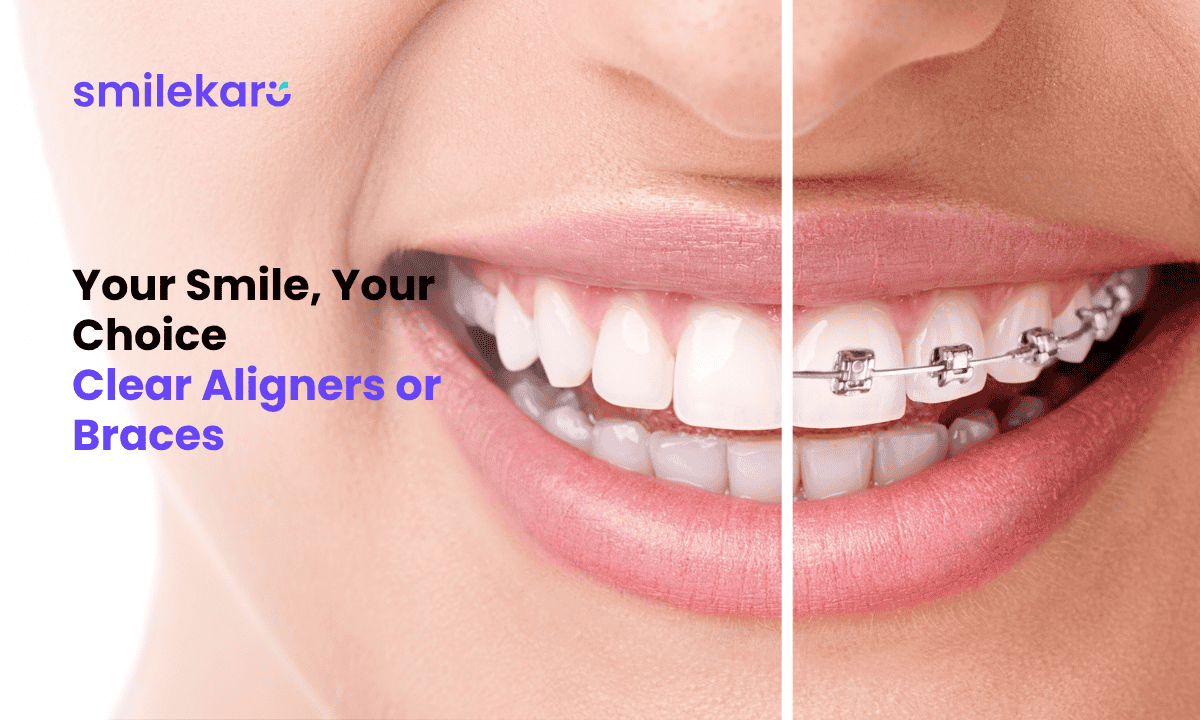So you want a straighter smile but can’t decide: Clear Aligners vs Braces? Don’t worry—you’re not alone. With so many teeth straightening options available, Gen Z is asking big questions like: aligners better than braces? braces vs aligners kya behtar hai?
At Smilekaro, we know you need more than just straight teeth—you want comfort, aesthetics, Insta-ready vibes, and something that fits your lifestyle. Let’s break down the difference between modern braces vs clear aligners, so you can choose what really works for you.
Read More: Can Smilekaro Fix Your Teeth?
What Are Clear Aligners and Braces?
Both aligners and braces are designed to fix crooked teeth, crowding, and bite issues—but the way they work (and look) is totally different.
How Clear Aligners Work
-
Transparent plastic trays (almost invisible)
-
Created through digital planning and 3D scans
-
Each tray applies gentle pressure, moving teeth step by step
-
Trays are swapped every 1–2 weeks
-
Worn 20–22 hours a day (remove only to eat, drink, brush)
Clear aligners kaise kaam karte hain? Ek ek tray se teeth shift hotay hain—smooth, gradual aur bina wires ke.
How Braces Work
-
Metal or ceramic brackets bonded to teeth
-
Connected by wires tightened during orthodontist visits
-
Continuous pressure moves teeth into place
-
Fixed—you can’t remove them until treatment ends
Invisible braces vs metal braces is also an option, since ceramic braces are less visible than traditional metallic ones.
Read More: Why Smilekaro Aligners Are Safe?
Clear Aligners vs Braces: Pros & Cons
Both have their strengths. Here’s the lowdown:
Advantages of Clear Aligners
-
Aesthetics: Nearly invisible (Insta-friendly!)
-
Removable: Eat what you want, when you want
-
Comfort: No wires poking your cheeks
-
Oral Hygiene: Easy brushing and flossing
-
Lifestyle: Great for athletes, performers, and busy students
Advantages of Braces
-
Control: Better for complex, severe cases
-
Fixed: No chance of “forgetting” to wear them
-
Affordable Options: Traditional metal braces can be cheaper
-
Effective: Works for all types of alignment issues
In short: Aligners = style + flexibility. Braces = strong control + reliability.
Read More: Who Designs Your Smile?
What Gen Z Should Consider
Your choice depends on more than just teeth—it’s about lifestyle, vibes, and priorities.
Gen Z Preferences
-
Aligners are invisible and Instagram-friendly
-
Removable = easy for social gatherings, selfies, and TikToks
-
No food restrictions (bye-bye popcorn bans)
Aligners for youth are trending because Gen Z wants solutions that look good while they’re working.
Budget, Compliance & Everyday Life
-
Aligners = slightly higher cost but less hassle
-
Braces = more clinic visits but can be cheaper
-
Aligners require discipline (20–22 hrs wear)
-
Braces require patience (can’t remove them, deal with wires)
Cost & Maintenance: Aligners vs Braces
Cost Comparison
-
Aligners cost vs braces cost depends on your case.
-
Aligners: Usually a bit pricier upfront but fewer repairs.
-
Braces: May be cheaper, but wire breakages and frequent visits can add up.
Maintenance & Cleaning
-
Clear aligner maintenance tips: Rinse trays, brush with mild soap, avoid hot water.
-
Braces: More challenging oral hygiene—requires special brushes and floss threaders.
Aligners = cleaner, easier, but pricier. Braces = budget-friendly, but higher maintenance.
Read More: 5 Reasons Why Gen Z is Choosing “SmileKaro” Over Braces
Suitability: Which One Is Best for You?
Aligners Work Best For
-
Mild to moderate crowding
-
Small gaps
-
Teens and young adults who can stay compliant
-
People who want an aesthetic option
Braces Work Best For
-
Severe bite issues (overbite, underbite, crossbite)
-
Jaw corrections
-
Patients who need constant, fixed force
Switching & Hybrid Approaches
Some patients start with braces for tough movements, then switch to aligners for finishing touches. Hybrid approaches = best of both worlds.
What to Expect During Treatment
Timeline & Visits
-
Aligners: Average 6–18 months, fewer clinic visits (digital monitoring).
-
Braces: 18–24 months, regular in-person adjustments.
Discomfort & Adaptation
-
Aligners: Mild pressure when switching trays, usually easier to adjust.
-
Braces: More initial discomfort, mouth sores from wires.
Either way, there’s an adaptation period but the results are worth it.
Conclusion
So, Clear Aligners vs Braces— which is better? The truth is, it depends on your goals. Aligners win in style, comfort, and flexibility. Braces win in handling complex cases and cost-effectiveness.
For Gen Z, who values aesthetics, convenience, and confidence, clear aligners better than braces is often true. But only a dentist can confirm the best option for your case.
✨ Ready to decide? Visit Smilekaro to explore How It Works and check if aligners are right for you.
FAQs – Gen Z’s Common Queries
Are aligners painful?
Not really. You’ll feel gentle pressure when changing trays, but no sharp wires = less pain than braces.
Can braces fix everything that aligners can?
Yes, and more. Braces handle severe cases that aligners sometimes can’t.
How many hours per day do you wear aligners?
20–22 hours daily. Think of them as part of your routine—sleep, study, gym, repeat.
Braces vs aligners kya behtar hai?
It depends on your case. For aesthetics and lifestyle=aligners. For complex issues = braces.
